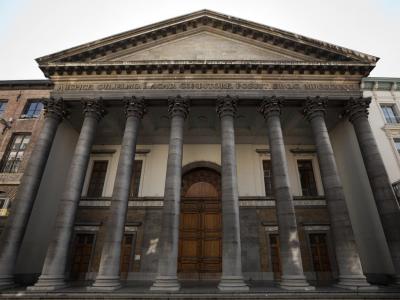
Aula Academica of Ghent University, Ghent
The Aula Academica, or Assembly Hall, is a landmark of Ghent University in Ghent, serving as a central symbol and significant historical site for the institution. Shortly after the University's founding in 1817, it was decided that a prominent auditorium was necessary to represent the new establishment. The foundation stone for the Aula Academica was laid on August 4, 1819, in the name of King Willem I, on the grounds of the former Jesuit church in Voldersstraat. The grand hall was inaugurated on October 3, 1826, and has since played a pivotal role in the histories of the Netherlands, Belgium, and the Flemish Movement.
Designed by the young architect Lodewijk Roelandt, the Aula Academica is a masterpiece of Neo-Classical architecture that marked the beginning of Roelandt's distinguished career. Its façade, inspired by the Pantheon in Rome, features a Prostylon of eight Corinthian columns sourced from the former infirmary of St. Peter's Abbey, topped by a pediment. A Latin inscription on the frieze commemorates King Willem I's commission of the building. Inside, the hall leads to the Academy Council Chamber, a significant part of the University's administrative and ceremonial activities.
During World War I, the Aula was actively involved in promoting Dutch culture in Belgium and played a role in the Dutchification of Ghent University. In 1988, it became the official symbol of the University when the old coat of arms on its façade was replaced with the image of the goddess Minerva, who symbolizes wisdom and learning.
Beyond its academic purpose, signified by a large statue of Minerva, the Aula has been a versatile venue hosting a variety of events, including emeritus ceremonies, symposiums, anniversaries, commemorations, and conferences. It has also been the site of numerous exhibitions, some not directly related to the University. The Aula is central to university traditions, as each academic year opens with a proclamation ceremony held there. In recognition of its architectural and historical significance, the Aula Academica was declared a protected monument in 1995.
Designed by the young architect Lodewijk Roelandt, the Aula Academica is a masterpiece of Neo-Classical architecture that marked the beginning of Roelandt's distinguished career. Its façade, inspired by the Pantheon in Rome, features a Prostylon of eight Corinthian columns sourced from the former infirmary of St. Peter's Abbey, topped by a pediment. A Latin inscription on the frieze commemorates King Willem I's commission of the building. Inside, the hall leads to the Academy Council Chamber, a significant part of the University's administrative and ceremonial activities.
During World War I, the Aula was actively involved in promoting Dutch culture in Belgium and played a role in the Dutchification of Ghent University. In 1988, it became the official symbol of the University when the old coat of arms on its façade was replaced with the image of the goddess Minerva, who symbolizes wisdom and learning.
Beyond its academic purpose, signified by a large statue of Minerva, the Aula has been a versatile venue hosting a variety of events, including emeritus ceremonies, symposiums, anniversaries, commemorations, and conferences. It has also been the site of numerous exhibitions, some not directly related to the University. The Aula is central to university traditions, as each academic year opens with a proclamation ceremony held there. In recognition of its architectural and historical significance, the Aula Academica was declared a protected monument in 1995.
Want to visit this sight? Check out these Self-Guided Walking Tours in Ghent. Alternatively, you can download the mobile app "GPSmyCity: Walks in 1K+ Cities" from Apple App Store or Google Play Store. The app turns your mobile device to a personal tour guide and it works offline, so no data plan is needed when traveling abroad.
Aula Academica of Ghent University on Map






Sight Name: Aula Academica of Ghent University
Sight Location: Ghent, Belgium (See walking tours in Ghent)
Sight Type: Attraction/Landmark
Guide(s) Containing This Sight:
Sight Location: Ghent, Belgium (See walking tours in Ghent)
Sight Type: Attraction/Landmark
Guide(s) Containing This Sight:
Walking Tours in Ghent, Belgium
Create Your Own Walk in Ghent
Creating your own self-guided walk in Ghent is easy and fun. Choose the city attractions that you want to see and a walk route map will be created just for you. You can even set your hotel as the start point of the walk.
Ghent Introduction Walking Tour
Some historians believe "Ghent" comes from the Celtic word, "ganda." "Ganda" meant a confluence, as with two rivers. There are traces of human settlements as far back as the stone age at the confluence of the rivers Scheldt and Leie in Belgium.
With the Frankish invasions at the end of the 4th century AD, the Celtic language was replaced by Old Dutch and this... view more
Tour Duration: 2 Hour(s)
Travel Distance: 1.7 Km or 1.1 Miles
With the Frankish invasions at the end of the 4th century AD, the Celtic language was replaced by Old Dutch and this... view more
Tour Duration: 2 Hour(s)
Travel Distance: 1.7 Km or 1.1 Miles
Ghent's Historical Buildings
The medieval city of Ghent is full of wonderful old buildings, some dating back as far as the 12th-13th centuries. Medieval buildings are indeed everywhere here, and if you're interested in the heritage fit to capture you imagination, you will find plenty of it in Ghent’s historic downtown.
And you won’t have to look far for the World Heritage worthy of its name either. The Castle of... view more
Tour Duration: 2 Hour(s)
Travel Distance: 2.8 Km or 1.7 Miles
And you won’t have to look far for the World Heritage worthy of its name either. The Castle of... view more
Tour Duration: 2 Hour(s)
Travel Distance: 2.8 Km or 1.7 Miles


